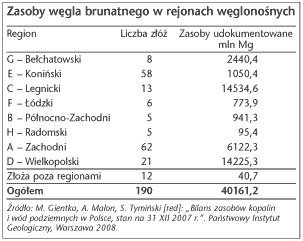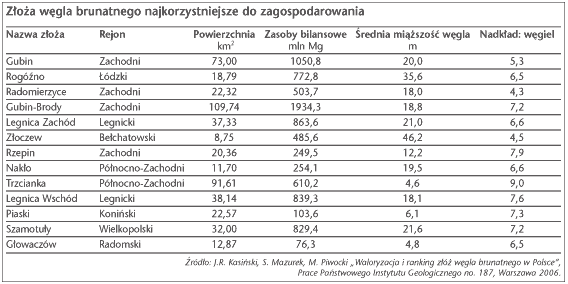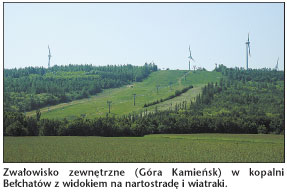|
Infrastruktura - Środowisko - Energia
Dodatek lobbingowy do "RZECZPOSPOLITEJ".
9 września 2008 r.
po polsku
Recognition status and basic problems
Brown coal deposits in Poland
dr Jacek Kasiński, Polish Geological Institute
 The problem of Poland's energy safety or simply of providing in the coming years the amount of energy sufficient for maintaining the economic growth of the country has recently become a widely perceived issue. Poland does not have any extensive instruments which could help prevent this situation: apart from - on the one hand - diminishing coal deposits which are located more and more deeply and - on the other - potential production of energy in nuclear power stations, what remains at Poland's disposal are in fact considerable and easily available brown coal deposits. The problem of Poland's energy safety or simply of providing in the coming years the amount of energy sufficient for maintaining the economic growth of the country has recently become a widely perceived issue. Poland does not have any extensive instruments which could help prevent this situation: apart from - on the one hand - diminishing coal deposits which are located more and more deeply and - on the other - potential production of energy in nuclear power stations, what remains at Poland's disposal are in fact considerable and easily available brown coal deposits.
Brown coal in Poland and the world
World brown coal deposits are to be found in a few countries, which include, apart from Poland, also Australia, China, the Czech Republic, Greece, Germany, Russia, the United States and Turkey. Extractable world brown coal deposits are assessed at 512 milliard Mg. In Poland such deposits are quite extensive, and, according to the recent data (Piwocki et al. 2004), they are assessed at 29,814.7 million Mg, among which indicated deposits (resources indicated in A + B + C1 + C2 categories) constitute 13,851.2 million Mg, while prospecting deposits (estimated resources in D category) constitute 15,963.5 million Mg.
Brown coal resource distribution
 Soft brown coals are common in the Polish Lowland area and its satellite basins in formations of Paleogene and Neogene while hard brown coals occur locally in formations of the Cretaceous in the North Sudetic basin and these of the Jurassic on the peripheries of the Śwętokrzyskie Mountains (Holy Cross Mountains). The only deposits of any practical importance are the Miocene soft brown coal deposits, which richly and commonly occur in the western part of Poland (map). It is precisely these deposits which nowadays constitute the most important source of energy materials in Poland. Soft brown coals are common in the Polish Lowland area and its satellite basins in formations of Paleogene and Neogene while hard brown coals occur locally in formations of the Cretaceous in the North Sudetic basin and these of the Jurassic on the peripheries of the Śwętokrzyskie Mountains (Holy Cross Mountains). The only deposits of any practical importance are the Miocene soft brown coal deposits, which richly and commonly occur in the western part of Poland (map). It is precisely these deposits which nowadays constitute the most important source of energy materials in Poland.
There is only one coal bed of economic importance: namely, the Oligocene (1) V bed of Czempin, which occur among the Paleogene formations over a distance of 7,700 km2 . This bed reaches considerable thickness values (up to 45 m) only in a few deposits (Rogóźno, Łąnięta, Bąkowo), none of which is exploited at present. Another bed of some importance is also the oldest Miocene bed (2), namely the IV bed of Dąbrowa, occurring over a distance of 7,000 km2 . More important from the economic point of view are younger beds occurring among the Miocene formations: (3) the III bed of Ścinawa, spread over a distance of approximately 30,000 and of the thickness reaching up to 35 m (deposits: Mosty, Ścinawa); (4) the II bed of Łużyce, covering the area of approximately 61,000 km2 and reaching the thickness of up to 40 m (deposits: Czempin, Gostyń, Krzywiń, Lubstów, Mosina, Naramowice, Radomierzyce, Szamotuły) or even up to 250 m in tectonic foredeeps (Bełchatów deposit); (5) the I bed of Middle Poland (środkowopolski), spreading over a distance of approximately 70,000 km2 and reaching the thickness of 20 m (deposits of the Konin region).
Renewability of resources
As a result of the economic changes Poland has undergone since 1989, searching and recognizing new mineral deposits have practically ceased to be financed from public expenditure. It was assumed that since the mining industry was to be privatized it should become responsible for recognizing new deposits. While this mechanism worked well for the deposits of common minerals, since 1993 a continuous loss of brown coal resources have been noticed; it results from the growing exploitation accompanied by the dramatic lack of new documentary works. The annual loss of resources caused by exploitation reaches over 60 million Mg. As works aimed at exploring brown coal deposits are time-consuming, expensive and, in spite of the progress in research methods, dangerous, enterpreneurs actually limit their documentary work to the known deposits, documenting them in higher categories for their own needs. It has been a continuous demand of the involved circles to transfer the risk of exploratory work to the state in the case of minerals of strategic importance. According to the current regulations, if the works are successful the potential investor is obliged to reimburse the expenses incurred for it anyway.
Valorization and deposit protection
Brown coal deposits, with some rare exceptions, are mined by means of the opencast method. Hence, the deposit protection should consists in protecting the area above the deposits against building development which could hinder or prevent the later exploitation of the deposits. Building a motorway through a deposit or erecting a housing development or a industrial plant above it increases the costs of the deposit exploitation so much that it becomes unprofitable. An appropriate investment scheme should therefore include the following stages:
-
recognizing the deposit;
- presenting it in the national resource list
- introducing the deposit into the regional and local land development plan.
Such a scheme makes it possible, in accordance with the regulations of The Geological and Mining Law as well as Spatial Planning and Development Act, to protect the deposit area against the inappropriate exploitation as well as to make it available for exploitation now or in the future.
Obviously, not all mineral deposits are of equal value. Absolute protection should involve only the most valuable deposits, i.e. those of a strategic importance for the country's economy. In the case of the less valuable deposits, another way of developing the area above them seems to be more rational from the social point of view. Therefore, valorization of mineral deposits is a very important issue.
In order to prepare data indispensable to take well-thought-out decisions concerning location as well as to intensify the necessary protection of brown coal deposits, extensive work has been done in Polish Geological Institute, the aim of which has been to update the resources of brown coal deposits and to valorize them from the economic and geo-environmental points of view as well as in terms of social acceptance for a potential investment. The conducted work has made it possible to single out deposits which are the most favourable in terms of the conditions of potential development (see table on page 5). Deposits presented in this table should be protected in an absolute way, which would facilitate their later development.

Why brown coal?
There have been diverse opinions concerning the use of brown coal as a material in professional power industry. Apart from claims against its economic competitiveness, the most serious charges have been levelled in the field of environmental protection. So what is the actual status quo of these issues?
In spite of the intention to increase the use of natural gas in power industry as well as the anticipated growth in the production of energy from renewable energy sources it is expected that in 2030 60 per cent of power will still be produced in power plants which make use of brown and hard coal. Brown coal, however, is nowadays the cheapest power source (about 19 USD/MWh, which constitutes 65 per cent of the costs of power obtained from hard coal). Four out of five largest power plants which make use of brown coal produce power cheaper than the cheapest "Opole" hard coal power plant. Favourable geological conditions together with the advanced mining technology (low transportation cost of large loads by means of conveyor belts is also significant here) result in the fact that when expressed in calorific value (caloricity) brown coal is the cheapest energy source in Poland and it will continue to be one in the foreseeable future.
Hazards to natural environment
caused by power industry based on brown coal combustion (coal mining and power production should be treated here as interconnected) are indeed considerable. However, the use of modern technologies, which is becoming wider and wider, together with the existing strict standards considering pollution discharge, considerably reduce the negative influence which this industry exerts on the environment. Potential hazards to the environment caused by mining activity include: (1) total transformation of the land surface within the outline of an opencast mine under construction, (2) hydrological and hydrogeological transformations related to the drainage of an opencast mine (lowering of the waterground level, drying of soil, affecting surface water), (3) geomechanical deformations on foreland and slopes of an opencast mine and the external dump (sinking and landslides development), (4) rockbursts related to decompression of rock mass, (5) pollution of atmospheric air, which results from dust discharge during exploitation and overburden dumping on the one hand and on the other from the discharge of gases occurring during coal fires in an opencast mine which are triggered by coal self-ignition, (6) surface water pollution (mainly in the form of suspension), and (7) noise emitted by equipment in operation. Apart from the above-mentioned hazards, there are also those caused by the power plant, such as: (8) pollution of atmospheric air resulting from dust and gases emitted during coal combustion, (9) thermal pollution of surface water (rivers and lakes), (10) chemical pollution of underground water resulting from the process of lixiviation of ash dumping sites, and finally (11) emission of considerable amounts of carbon dioxide into the atmosphere.
Reclamation
 Modern technologies, which are used more and more widely, considerably reduce hazards in nearly all above-mentioned fields. Although it is impossible to avoid (1) total transformation of the land surface within the boundaries of an opencast mine, the process of reclamation - if properly conducted - makes it possible to obtain fully valuable farming or forest areas as well as water bodies, which are given back to the country's economy after the period of 20-30 years. It often happens that the mine returns to the district farming areas of higher soil valuation class as compared to those which it used to exploit itself; such a situation can be observed, for instance, in the "Konin" mine. Post-mining areas are becoming also an attractive holidays destination, especially in regions which lack natural elements; a good example here is the region of Cologne in Germany. (2) hydrological and hydrogeological transformations cannot be avoided either; their undesirable effects, however, can be reduced by means of appropriate crops and the development of rural waterworks, while proper reclamation eventually leads to the restoration of proper relationships within rock mass. Geomechanical deformations (3) and rockbursts (4) are considerably less intense in comparison to those occurring in underground mining; besides, their intensity can be minimised by properly designed drift and dump slopes (the wide use of internal dump). Dust discharge in the mine (5), which is relatively little by nature, is reduced by applying water spraying during periods of drought, while noise emission (strictly limited by the standards) is reduced by erecting acoustic screens. It is however coal combustion technology which has witnessed the most significant changes in favour of the environment. Modern units equipped with a fluid bed for coal combustion cause practically no (8) pollution of atmospheric air (both coal and its combustion by-products circulate in a closed cycle until their complete decomposition); what becomes emitted to the atmosphere is only CO2 and steam. Thermal pollution of surface water (9) occurred only when an open cooling cycle was used as it is still done today in "Konin" and "Pątnów" power plants. In newly constructed power plants this problem is eliminated by the application of a closed cycle only (cooling towers). The problem of pollution filtering from ash dumping sites (10) becomes eliminated by the use of insulating screens made of ion exchange materials (beidellite-smectite clays) as well as by the petrification of furnace waste mass, which is becoming more and more popular. Modern technologies, which are used more and more widely, considerably reduce hazards in nearly all above-mentioned fields. Although it is impossible to avoid (1) total transformation of the land surface within the boundaries of an opencast mine, the process of reclamation - if properly conducted - makes it possible to obtain fully valuable farming or forest areas as well as water bodies, which are given back to the country's economy after the period of 20-30 years. It often happens that the mine returns to the district farming areas of higher soil valuation class as compared to those which it used to exploit itself; such a situation can be observed, for instance, in the "Konin" mine. Post-mining areas are becoming also an attractive holidays destination, especially in regions which lack natural elements; a good example here is the region of Cologne in Germany. (2) hydrological and hydrogeological transformations cannot be avoided either; their undesirable effects, however, can be reduced by means of appropriate crops and the development of rural waterworks, while proper reclamation eventually leads to the restoration of proper relationships within rock mass. Geomechanical deformations (3) and rockbursts (4) are considerably less intense in comparison to those occurring in underground mining; besides, their intensity can be minimised by properly designed drift and dump slopes (the wide use of internal dump). Dust discharge in the mine (5), which is relatively little by nature, is reduced by applying water spraying during periods of drought, while noise emission (strictly limited by the standards) is reduced by erecting acoustic screens. It is however coal combustion technology which has witnessed the most significant changes in favour of the environment. Modern units equipped with a fluid bed for coal combustion cause practically no (8) pollution of atmospheric air (both coal and its combustion by-products circulate in a closed cycle until their complete decomposition); what becomes emitted to the atmosphere is only CO2 and steam. Thermal pollution of surface water (9) occurred only when an open cooling cycle was used as it is still done today in "Konin" and "Pątnów" power plants. In newly constructed power plants this problem is eliminated by the application of a closed cycle only (cooling towers). The problem of pollution filtering from ash dumping sites (10) becomes eliminated by the use of insulating screens made of ion exchange materials (beidellite-smectite clays) as well as by the petrification of furnace waste mass, which is becoming more and more popular.
CO2 sequestration
At present, the most difficult problem is (11) emission of considerable amounts of carbon dioxide. Measures taken towards the solution of this problem include applying modern low-emission technologies of carbon combustion (e.g. oxy-combustion), and first of all, CO2 sequestration in deep geological structures. Undoubtedly, however, considering the present European Union policy, the requirement of zero emission combustion will considerably increase the production costs of brown coal power, as well as of power produced from other fossil fuels.
*
It should be hoped that in the future classical coal mining and combustion will become partly replaced by unconventional technologies of processing coal directly in its deposit, such as underground gasification (the production of syngas) or microbiological hydrogenation (the production of methane). Such methods, however, remain at present at an experimental stage only, and there is some evidence that contrary to what has been assumed their application is by no means neutral for the natural environment. Nevertheless, today it seems perfectly reasonable to create pilot installations for carefully selected deposits.
The possibility of making brown coal more environment-friendly can be proven by the fact that brown coal remains a significant energy material in Germany, the United States or Australia, although all these countries have developed truly restrictive regulations concerning environmental protection.
Considering the fact that costs of energy obtained from renewable sources are considerably higher than those related to the combustion of fossil fuels it can be believed that, with the application of clean combustion technologies, brown coal will remain one of the fundamental energy materials for yet a long time, both in the world and in Poland. Unlike in the case of hydrocarbons, brown coal is not threatened by quick depletion of resources, as its world resources ensure the maintenance of the present mining level for 500 years. In Poland, too, its resources should be sufficient for a similar period of time; therefore, the increase in brown coal mining (or even maintaining it at the current level) would significantly contribute towards ensuring the country's energy safety.
The principles of the country's energy policy up to 2030 provide for opening new brown coal mines; the necessary decisions, however, have to be taken already now. n
www.pgi.gov.pl
|

